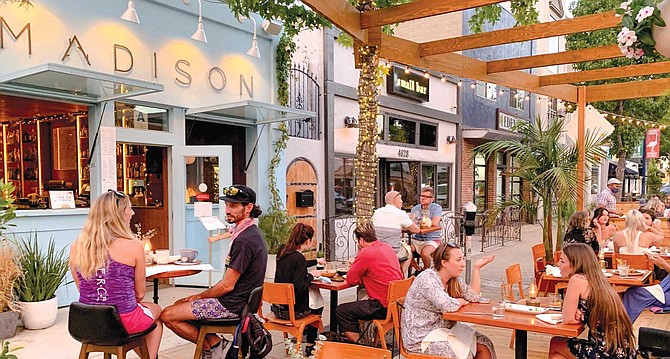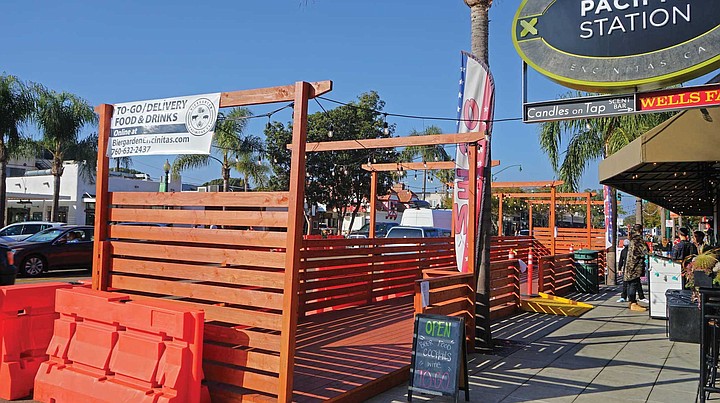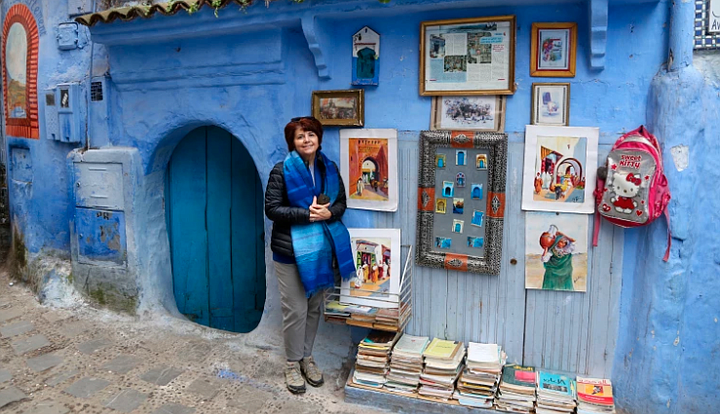 Facebook
Facebook
 X
X
 Instagram
Instagram
 TikTok
TikTok
 Youtube
Youtube

As the city moves to make outdoor dining permanent, a few hitches remain.
Spaces as Places, a post-pandemic draft plan to develop the many outdoor niches discovered during lockdown more fully, isn't only about dining.
The city wants its streeteries, social curbs, promenades, and private outdoor dining to advance climate goals. Wider sidewalks. Extra room for outdoor tables. More space for pedestrians and bicyclists to use the streets safely.

Is it even possible? Many outdoor patios already block sidewalks and bike paths in North Park. Vibrant new spaces "cannot come at the expense of transit, bicycle, or pedestrian infrastructure," says a letter from Circulate San Diego.
San Diego's bike and transit network is itself a work in progress. In some cases, planned bicycle or transit lanes are years away. Advocates support the program, but worry that restaurants may come to depend on that space and feel entitled to it.
"This can already be seen in conflicts around outdoor dining facilities that have been built in the way of the planned 30th street bikeway."
As of June 25, 2021, the city has approved 435 applications for temporary outdoor business operations. In May, the city extended the permits until July 2022, and some restaurants that kept their outdoor dining have parklets that intrude into bike lanes.
The plan is to have Spaces as Places up and running when the current permits expire next year.

To avoid future conflicts, Circulate San Diego says the program should not allow interim use of public right of way where new bike lanes are planned, as shown in SANDAG's 2021 Regional Plan, the city's Bicycle Master Plan, and individual community plans.
Future transit lanes are harder to figure. The draft regional plan isn't clear which Rapid buses will run on dedicated right-of-way, they say, so the program should not use any right-of-way along planned Rapid bus lines.
Spaces as Places includes streetaries, where restaurants and breweries take over former parking spots; social curbs, a permanent extension of curb into parking lanes for recreation, dining or socializing; dining in private parking lots in transit priority areas; and promenades where streets are partially or completely closed to vehicles.
Juggling such spaces in San Diego's urban terrain requires the planning department to develop regulations that comply with fire safety and access, stormwater, ADA accessibility, and traffic safety codes.
A design manual is being developed to go with the proposed regulations, which include a fee structure based on square footage for the exclusive use of the public right-of-way. Public input includes surveys, two workshops, and hearings in July and August.
A majority of respondents wanted outdoor dining to continue, and walkability was high on the wish list.
The city emphasizes that safety is the priority. Bicyclists couldn't agree more on the need for protected lanes. In only a month, five local cyclists have died while riding; most recently on Pershing Drive when a car veered into the bike lane, killing Laura Shinn, SDSU's director of facilities planning.
Circulate San Diego suggests that for streets with speed limits over 25 mph, streeteries should be protected from traffic using quick-build projects that require only paint, planter boxes, and flex posts. Far cheaper than permanent curb extensions, they create safety through visual and physical separation and barriers like bollards.
At a meeting of the Covid-19 Response and Recovery Committee on July 26, council members asked planners about patios jutting into the roadway and other safety issues.
"How are we going to prevent cars from crashing into seating?" councilmember Whitburn asked.
Planning staff said a 42-inch barrier, considered a good measure of safety and visibility, will be required. In addition, street trees must be elevated and flush with sidewalks.
Councilmember Rivera asked about plans to slow traffic, saying barricades might not stop a car going 50 mph.
Staff said street trees would only be allowed where the speed limit is 30 mph. Asked how the city will approach conflicts with bike lanes and parklets, planners replied that street trees won't be allowed where there are bike lanes.
Jacob Mandel, with the San Diego County Bicycle Coalition, says they fully support businesses taking over parking spaces for outdoor dining - "so long as they comply with the rules and regulations of their permit."
A few businesses have taken over bike lanes, and per the terms of their permit, agreed to maintain the bikeway around the outdoor dining area, he says. Most have complied.
But not all.
"We call on the city to take immediate action to address the businesses that don't comply with their permit and maintain the bicycle infrastructure around their outdoor dining."
Mandel says businesses that aren't complying with their permit create dangerous situations for cyclists by forcing them out into traffic.
The Coalition supports the proposed program, he says, which they see as an opportunity for the city to create meaningful public spaces and badly needed infrastructure.
The real issue isn't outdoor dining blocking bicycle lanes. "It's that our city has given away valuable public space to motor vehicles for free, leaving small businesses, cyclists, and pedestrians to fight over a minuscule amount of pavement."
The program will be considered for adoption by the city council this fall.


As the city moves to make outdoor dining permanent, a few hitches remain.
Spaces as Places, a post-pandemic draft plan to develop the many outdoor niches discovered during lockdown more fully, isn't only about dining.
The city wants its streeteries, social curbs, promenades, and private outdoor dining to advance climate goals. Wider sidewalks. Extra room for outdoor tables. More space for pedestrians and bicyclists to use the streets safely.

Is it even possible? Many outdoor patios already block sidewalks and bike paths in North Park. Vibrant new spaces "cannot come at the expense of transit, bicycle, or pedestrian infrastructure," says a letter from Circulate San Diego.
San Diego's bike and transit network is itself a work in progress. In some cases, planned bicycle or transit lanes are years away. Advocates support the program, but worry that restaurants may come to depend on that space and feel entitled to it.
"This can already be seen in conflicts around outdoor dining facilities that have been built in the way of the planned 30th street bikeway."
As of June 25, 2021, the city has approved 435 applications for temporary outdoor business operations. In May, the city extended the permits until July 2022, and some restaurants that kept their outdoor dining have parklets that intrude into bike lanes.
The plan is to have Spaces as Places up and running when the current permits expire next year.

To avoid future conflicts, Circulate San Diego says the program should not allow interim use of public right of way where new bike lanes are planned, as shown in SANDAG's 2021 Regional Plan, the city's Bicycle Master Plan, and individual community plans.
Future transit lanes are harder to figure. The draft regional plan isn't clear which Rapid buses will run on dedicated right-of-way, they say, so the program should not use any right-of-way along planned Rapid bus lines.
Spaces as Places includes streetaries, where restaurants and breweries take over former parking spots; social curbs, a permanent extension of curb into parking lanes for recreation, dining or socializing; dining in private parking lots in transit priority areas; and promenades where streets are partially or completely closed to vehicles.
Juggling such spaces in San Diego's urban terrain requires the planning department to develop regulations that comply with fire safety and access, stormwater, ADA accessibility, and traffic safety codes.
A design manual is being developed to go with the proposed regulations, which include a fee structure based on square footage for the exclusive use of the public right-of-way. Public input includes surveys, two workshops, and hearings in July and August.
A majority of respondents wanted outdoor dining to continue, and walkability was high on the wish list.
The city emphasizes that safety is the priority. Bicyclists couldn't agree more on the need for protected lanes. In only a month, five local cyclists have died while riding; most recently on Pershing Drive when a car veered into the bike lane, killing Laura Shinn, SDSU's director of facilities planning.
Circulate San Diego suggests that for streets with speed limits over 25 mph, streeteries should be protected from traffic using quick-build projects that require only paint, planter boxes, and flex posts. Far cheaper than permanent curb extensions, they create safety through visual and physical separation and barriers like bollards.
At a meeting of the Covid-19 Response and Recovery Committee on July 26, council members asked planners about patios jutting into the roadway and other safety issues.
"How are we going to prevent cars from crashing into seating?" councilmember Whitburn asked.
Planning staff said a 42-inch barrier, considered a good measure of safety and visibility, will be required. In addition, street trees must be elevated and flush with sidewalks.
Councilmember Rivera asked about plans to slow traffic, saying barricades might not stop a car going 50 mph.
Staff said street trees would only be allowed where the speed limit is 30 mph. Asked how the city will approach conflicts with bike lanes and parklets, planners replied that street trees won't be allowed where there are bike lanes.
Jacob Mandel, with the San Diego County Bicycle Coalition, says they fully support businesses taking over parking spaces for outdoor dining - "so long as they comply with the rules and regulations of their permit."
A few businesses have taken over bike lanes, and per the terms of their permit, agreed to maintain the bikeway around the outdoor dining area, he says. Most have complied.
But not all.
"We call on the city to take immediate action to address the businesses that don't comply with their permit and maintain the bicycle infrastructure around their outdoor dining."
Mandel says businesses that aren't complying with their permit create dangerous situations for cyclists by forcing them out into traffic.
The Coalition supports the proposed program, he says, which they see as an opportunity for the city to create meaningful public spaces and badly needed infrastructure.
The real issue isn't outdoor dining blocking bicycle lanes. "It's that our city has given away valuable public space to motor vehicles for free, leaving small businesses, cyclists, and pedestrians to fight over a minuscule amount of pavement."
The program will be considered for adoption by the city council this fall.
Comments